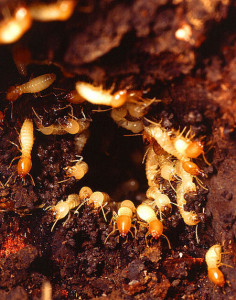Four Common Misconceptions About Subterranean Termites
By Chris Williams on July 1, 2014.
1. Termites only attack older wood in older homes. New wood is safe from termite attack for many years.
FACT – Termites will and do attack new wood. They generally prefer wood that has a high moisture content, or is softened by water damage or rot. But plenty of new homes have temporary leaks or damp crawlspaces. In fact, new homes usually have a higher wood moisture content than older homes. The reason for this misconception is that new homes are required to have a preconstruction termite treatment which should protect them for many years, while older homes may have outlived their initial termite treatment and are vulnerable to attack.
2. If you find holes in beams and sawdust piles underneath, it means you have a serious termite infestation.
FACT – It might mean you have a serious wood borer infestation, but not a termite infestation. Subterranean termites do not produce “sawdust” as a result of their activities, and they don’t leave exit holes in the wood. Termites ingest the wood, not just excavate it. Carpenter ants, powderpost beetles, and old house borer beetles can, however, leave fine wood shavings as they create galleries or chew exit holes in wood.
3. Placing wood around the outside of your home will keep termites from reaching and attacking your house.
FACT – This works only if the wood is impregnated with termite bait. Placing scrap wood around the outside of your home could mean you will have termite colonies just that much closer to your house. Termites forage and find wood randomly; they are not attracted to it. So termites finding the scrap wood are just as likely to find your home.
4. If you find mud tubes on your house, it means termites have been feeding in your home for some time.
FACT – First, you need to distinguish between short mud tubes made by mud dauber wasps and the longer, winding mud tubes made by subterranean termites. Termites build mud tube highways to keep themselves from drying out and for protection from predators as they travel between their nests in soil and wood. Mud tubes are often exploratory as termites try to find a good source of wood to infest, so finding tubes does not necessarily mean your home is already infested, but it does mean that the termites have managed to breach the protective chemical barrier around your home. Calling an exterminator would be a smart move.
Photo [Public Domain]
